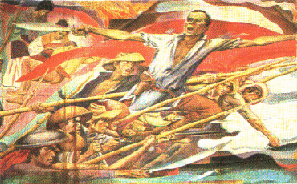
Instead of acceding to Aguinaldo's request, Dewey gave the latter a steam pinnace, a smaller but fast boat
tender retrieved by the Americans from the Spanish Admiral Montojo's man o'war, the Reina Cristina,
one of the ships of the Spanish Armada. This steam launch was just what Aguinaldo wanted most at the moment.
Aguinaldo was overjoyed as soon as he officially accepted the pinnace and christened it Magdalo
in honor of his group in the Katipunan during the Tejeros Convention. A pinnace in Europen navies could be a pulling
or powered caravel-built boat over 30 feet long. After the turnover of the ship's crews to the Filipinos, Aguinaldo hoisted the Filipino
flag, and Dewey allowed the Magdalo to ply freely from coast to coast. This launch serviced General
Aguinaldo who established his temporary headquarters in Cavite near the arsenal.
Admiral Dewey who did not attach any significance to the display of the Filipino flag gave the Filipino
rebels the liberty to enjoy his prized gift. However, the German fleet commander protested
to the flying of the "insurgent" flag in Philippine vessels. Thus, it was perceived that the Filipino flag was recognized
by the world. Soon, thereafter, other steamboats hoisted the Filipino flag in their masts.
After regrouping in Cavite, Aguinaldo formed the dictatorial government on May 24 and the 28th of the same
month the historic battle of Alapang broadcasted to the world the valor and elan of Aguinaldo's forces. Having
proclaimed himself dictator of the newly-established government, generals and other leaders visited Aguinaldo
at his headquarters and offered their services in the renewed struggle for independence.
On May 31, the date General Aguinaldo set to formally commence the second phase of the fight
against Spain, many shipowners and shipmasters saw him and offered their maritime services. One of these
was Ship Captain Simplicio Agoncillo Orosa. He was in command of the steamboat "Bulusan" which plied
between Lemery , Manila and Calapan in Mindoro. Captain Orosa brought some supplies to the
government and General Aguinaldo asked him to place his ship under the control of the revolutionaries to
become part of the envisioned "Mosquito Fleet."
While General Aguinaldo was busy restructuring the revolutionary government, eight Spanish
steam launches were renovated at the Cavite arsenal and fitted with guns. These were augmented
with the ships of the merchant marine of larger tonnage.
Among these were the Taaleņo, Balayan, Taal, Batangas, and Purisima Concepcion donated
by their rich owners, Leon Apacible and Manuel Lopez. All the boats were fitted with guns taken from damaged
Spanish ships of the squadron of Admiral Montojo.
All the ships were flying the Filipino flag that was designed by the Hongkong Committee and Doņa
marcela Agoncillo, assisted by Mrs. Herbosa de Natividad, a niece of Dr. Jose Rizal. The same flag was
also borne by ground troops in their campaigns and by the flotilla carrying General Aguinaldo's dispatches
and troops to the southern islands. (The Birth of the Navy of the Revolution; Prof. Regino Dodds Giagonia,
MNSA).
Note:Mural drawing copyright of Philippine Centennial page,